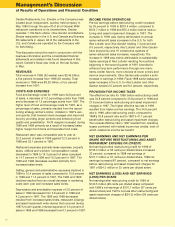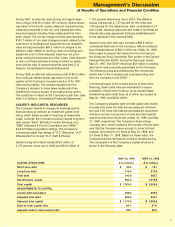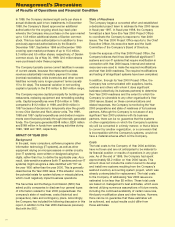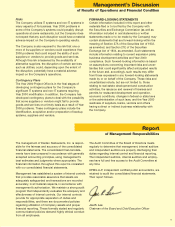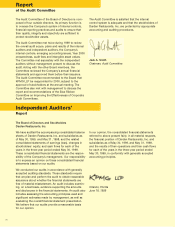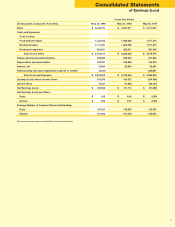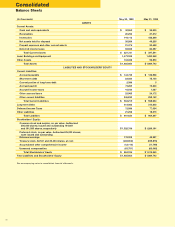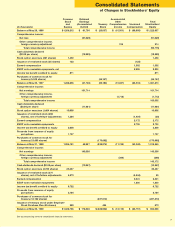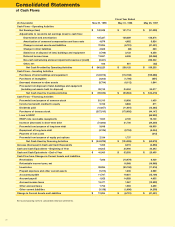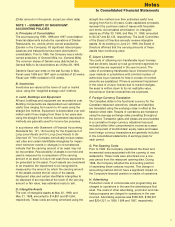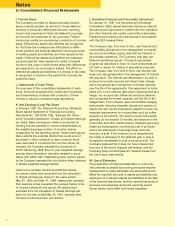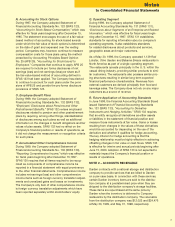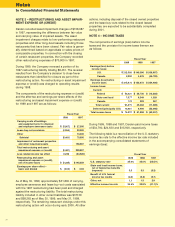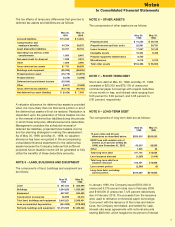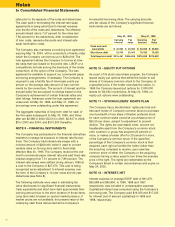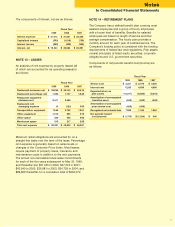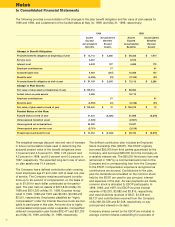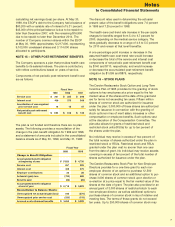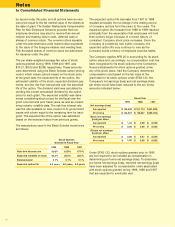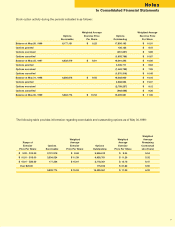Red Lobster 1999 Annual Report Download - page 10
Download and view the complete annual report
Please find page 10 of the 1999 Red Lobster annual report below. You can navigate through the pages in the report by either clicking on the pages listed below, or by using the keyword search tool below to find specific information within the annual report.
Notes
to Consolidated Financial Statements
31
(Dollar amounts in thousands, except per share data)
NOTE 1 – SUMMARY OF SIGNIFICANT
ACCOUNTING POLICIES
A. Principles of Consolidation
The accompanying 1999, 1998 and 1997 consolidated
financial statements include the operations of Darden
Restaurants, Inc. and its wholly owned subsidiaries
(Darden or the Company). All significant intercompany
balances and transactions have been eliminated in
consolidation. Prior to 1996, the Company was a wholly-
owned subsidiary of General Mills, Inc. (General Mills).
The common shares of Darden were distributed by
General Mills to its stockholders as of May 28, 1995.
Darden’s fiscal year ends on the last Sunday in May.
Fiscal years 1999 and 1997 each consisted of 52 weeks.
Fiscal year 1998 consisted of 53 weeks.
B. Inventories
Inventories are valued at the lower of cost or market
value, using the “weighted average cost” method.
C. Land, Buildings and Equipment
All land, buildings and equipment are recorded at cost.
Building components are depreciated over estimated
useful lives ranging from seven to 40 years using the
straight-line method. Equipment is depreciated over esti-
mated useful lives ranging from three to ten years also
using the straight-line method. Accelerated depreciation
methods are generally used for income tax purposes.
In accordance with Statement of Financial Accounting
Standards No. 121, “Accounting for the Impairment of
Long-Lived Assets and for Long-Lived Assets to Be
Disposed Of,” the Company periodically reviews restau-
rant sites and certain identifiable intangibles for impair-
ment whenever events or changes in circumstances
indicate that the carrying amount of an asset may not
be recoverable. Recoverability of assets to be held and
used is measured by a comparison of the carrying
amount of an asset to future net cash flows expected to
be generated by the asset. If such assets are considered
to be impaired, the impairment to be recognized is
measured by the amount by which the carrying amount
of the assets exceed the fair value of the assets.
Restaurant sites and certain identifiable intangibles to
be disposed of are reported at the lower of the carrying
amount or fair value, less estimated costs to sell.
D. Intangible Assets
The cost of intangible assets at May 30, 1999, and
May 31, 1998, amounted to $14,851 and $14,594,
respectively. These costs are being amortized using the
straight-line method over their estimated useful lives
ranging from five to 40 years. Costs capitalized principally
represent the purchase costs of leases with favorable
rent terms. Accumulated amortization on intangible
assets as of May 30, 1999, and May 31, 1998, amounted
to $4,347 and $5,135, respectively. The Audit Committee
of the Board of Directors annually reviews intangible
assets. At its meeting on June 21, 1999, the Board of
Directors affirmed that the carrying amounts of these
assets have continuing value.
E. Liquor Licenses
The costs of obtaining non-transferable liquor licenses
that are directly issued by local government agencies for
nominal fees are expensed in the year incurred. The
costs of purchasing transferable liquor licenses through
open markets in jurisdictions with a limited number of
authorized liquor licenses for fees in excess of nominal
amounts are capitalized. If there is permanent impairment
in the value of a liquor license due to market changes,
the asset is written down to its net realizable value.
Annual liquor license renewal fees are expensed.
F. Foreign Currency Translation
The Canadian dollar is the functional currency for the
Canadian restaurant operations. Assets and liabilities
are translated using the exchange rates in effect at the
balance sheet date. Results of operations are translated
using the average exchange rates prevailing throughout
the period. Translation gains and losses are accumulated
in a cumulative foreign currency adjustment account
included within other comprehensive income as a sepa-
rate component of stockholders’ equity. Gains and losses
from foreign currency transactions are generally included
in the consolidated statements of earnings (loss) for
each period.
G. Pre-Opening Costs
Prior to 1998, the Company capitalized the direct and
incremental costs associated with the opening of new
restaurants. These costs were amortized over a one-
year period from the restaurant opening date. During
1998, the Company adopted the accounting practice
of expensing these costs as incurred. This change in
accounting method did not have a significant impact on
the Company’s financial position or results of operations.
H. Advertising
Production costs of commercials and programming are
charged to operations in the year the advertising is first
aired. The costs of other advertising, promotion and mar-
keting programs are charged to operations in the year
incurred. Advertising expense was $180,563, $186,261
and $204,321, in 1999, 1998 and 1997, respectively.

